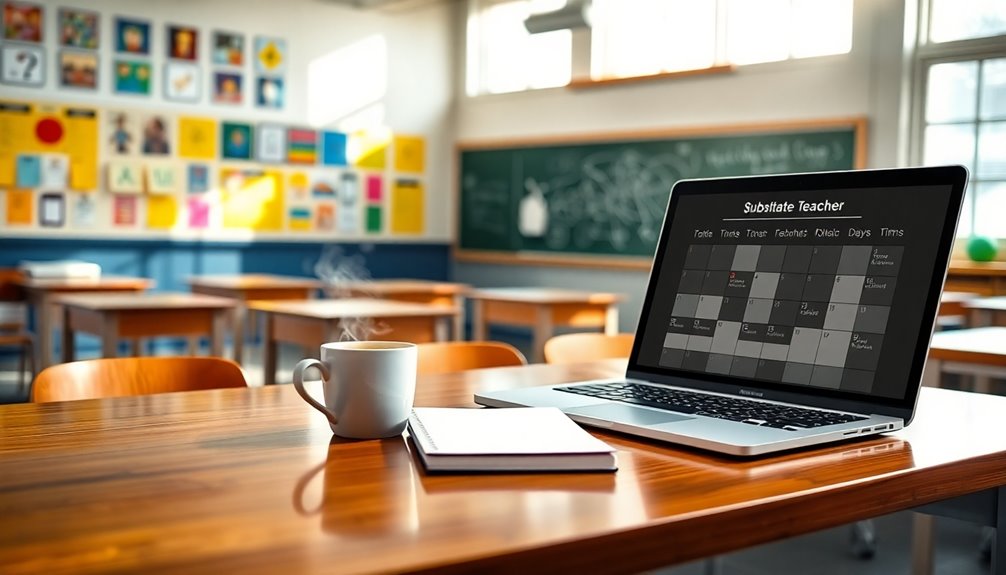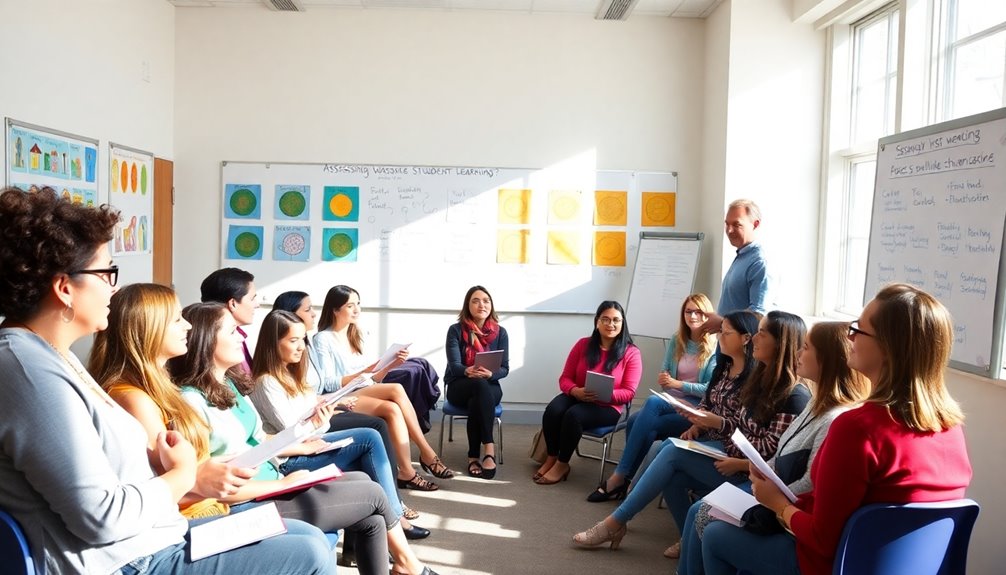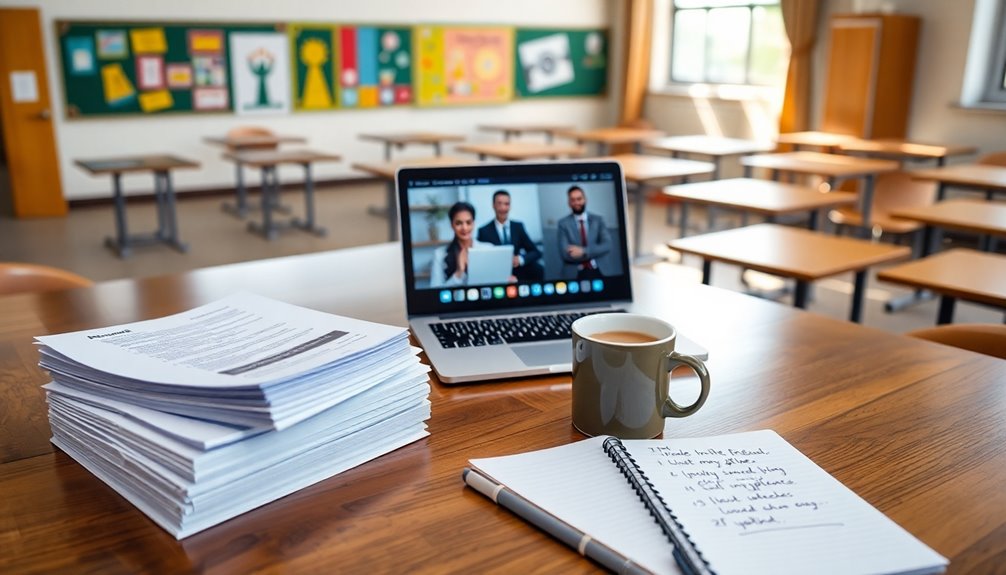When preparing for a substitute teacher interview, you should expect essential questions that assess your adaptability, classroom management skills, and familiarity with lesson plans. Be ready to discuss how you engage students and maintain a positive environment, even when unexpected challenges arise. Interviewers may also ask about your strategies for effective communication with both students and staff. Highlight your flexibility and willingness to learn from feedback. Remember, showcasing your ability to create a respectful rapport with students can set you apart. There's much more to contemplate, so keep exploring to boost your chances for success.
Key Takeaways
- What strategies do you use to establish rapport and manage classroom behavior effectively as a substitute teacher?
- How do you adapt lesson plans to meet the diverse needs of students in different grade levels?
- Can you provide an example of a challenging situation you faced in the classroom and how you handled it?
- What is your approach to communicating feedback and collaborating with regular teachers after a substitute assignment?
- How do you ensure student engagement and participation during a lesson, especially when following a pre-prepared plan?
General Interview Questions

Maneuvering through the general interview questions is essential for a substitute teacher candidate. You'll likely face questions about your personal background, motivations, and teaching experiences.
Be prepared to answer, "Tell me about yourself," as it helps the interviewer gauge your self-awareness. When asked about your strengths and weaknesses, focus on self-evaluation.
Expect inquiries like, "Why do you want to be a substitute teacher?" to assess your passion for education. You may also need to describe your teaching preference, favorite subjects, and educational qualifications.
Practicing concise responses will help you feel confident and articulate during the interview. Remember, these questions aim to understand your commitment and fit for the role, so answer honestly and thoughtfully.
Classroom Management Techniques

Effective classroom management techniques are essential for creating a conducive learning environment. You need to establish clear rules and expectations right from the start. This helps students understand what's acceptable and what's not.
When faced with disruptive behavior, address it calmly and consistently, using strategies like redirection or positive reinforcement. It's vital to stay adaptable; every class is different, and you might need to adjust your approach on the fly.
Document incidents, too; this feedback can aid the regular teacher later. Building rapport with students fosters respect and cooperation, making management smoother.
Engaging Student Strategies

Engaging students in the classroom is essential for fostering effective learning experiences. To capture their attention, you can employ various strategies tailored to different age groups. Here's a quick reference table to help you remember some effective methods:
| Age Group | Engagement Strategies |
|---|---|
| Elementary | Use physical activities |
| Middle School | Encourage group discussions |
| High School | Integrate technology |
| All Levels | Use visual aids |
| Any Age | Incorporate games and competitions |
Lesson Plan Adherence

When stepping into a classroom as a substitute teacher, adhering to the lesson plan is essential for maintaining continuity and ensuring that students receive a consistent learning experience.
Familiarize yourself with the provided materials and objectives before the class starts. This preparation helps you stay on track and effectively address students' questions.
While it's important to follow the plan, remain open to adjusting your approach based on the students' needs and engagement levels. If you notice certain activities aren't resonating, feel free to pivot, but keep the core objectives in mind.
Finally, leave detailed notes for the regular teacher, highlighting what worked well and any challenges you faced, ensuring a smooth shift for the next class.
Availability and Flexibility

Being available and flexible as a substitute teacher is vital in maneuvering the unpredictable nature of the job. Schools often need substitutes at a moment's notice, so showing that you're willing to step in last-minute can set you apart.
It's important to communicate your availability clearly, whether you're open on weekdays, weekends, or specific times. Being flexible also means you should feel comfortable covering various grade levels and subjects, adapting to different classroom environments as needed.
This adaptability helps maintain consistency for students, which is significant in their learning experience. By demonstrating your commitment to being available, you'll foster strong relationships with school administrators and teachers, making you a preferred choice for future assignments.
Professional Development Opportunities

Continuing on the path of adaptability, pursuing professional development opportunities is key to enhancing your skills as a substitute teacher. Engaging in workshops and training sessions keeps you updated with the latest teaching strategies and classroom management techniques.
Networking with other educators allows you to share experiences and gain insights that can improve your practices. Don't hesitate to utilize online resources for continuous learning; they offer flexibility and a wealth of information at your fingertips.
Seeking feedback from peers helps you identify areas for growth and enhances your effectiveness in the classroom. By actively pursuing these opportunities, you not only boost your confidence but also demonstrate your commitment to providing the best educational experience for your students.
Creating a Positive Environment

Creating a positive classroom environment is essential for effective learning, as it fosters student engagement and cooperation. To achieve this, you need to build rapport with students quickly. Start by learning their names and showing genuine interest in their lives.
Establishing clear classroom rules early on helps create a respectful atmosphere. Encourage cooperation by promoting group activities that allow students to work together. Adapt your approach to different classroom cultures and dynamics, recognizing that each group is unique.
Use positive reinforcement to acknowledge good behavior and effort, making students feel valued. When students feel safe and respected, they're more likely to engage actively in their learning and contribute positively to the classroom environment.
Effective Communication Skills

Effective communication skills are essential in a substitute teaching role, as they enhance interactions with students, staff, and parents alike. You need to express ideas clearly and listen actively to understand student needs and concerns.
Adapt your communication style to suit different age groups, ensuring that your messages resonate effectively. Using technology, like emails or online platforms, can further enhance parent-teacher communication.
Furthermore, demonstrating empathy and patience fosters trust and encourages open dialogue with students. Remember, non-verbal cues also play a significant role; maintaining eye contact and using positive body language can create a more engaging atmosphere.
Ultimately, strong communication skills will help you build rapport and create a supportive learning environment.
Emergency Preparedness

Being prepared for emergencies is crucial for substitute teachers, as unexpected situations can arise at any moment.
You should familiarize yourself with the school's emergency protocols, including procedures for fire drills, lockdowns, and natural disasters. Knowing where emergency exits and first aid kits are located can make a significant difference.
During a crisis, aim to keep students calm and focused; your demeanor can greatly influence their reactions. Clear communication is essential, so practice conveying instructions simply and assertively.
Document any incidents that occur for future reference, which can help regular teachers understand what happened. By being proactive and prepared, you can guarantee a safe environment for both yourself and your students during emergencies.
Assessing Student Learning

Evaluating student learning is vital for understanding how well your teaching methods resonate with students.
You'll want to incorporate informal assessments during lessons, like asking questions or using quick quizzes, to gauge comprehension. This immediate feedback helps you adapt your approach on the spot.
Providing constructive feedback is essential, too; it guides students and encourages growth. Keep an eye on patterns in their performance, as these insights will inform your future lesson plans.
Also, don't hesitate to ask students for their feedback on your teaching methods—this can provide valuable perspectives.
Frequently Asked Questions
What Technologies Are You Comfortable Using in the Classroom?
You're comfortable using a variety of technologies in the classroom, like smartboards, projectors, and document cameras.
You've also worked with educational software, such as Google Classroom and Kahoot, to enhance student engagement.
You know how to integrate tablets and laptops into lessons, ensuring students can access online resources.
You're familiar with using video conferencing tools for remote learning, which helps maintain interaction when needed.
Adapting to new tech is something you enjoy.
How Do You Handle Diverse Learning Needs Among Students?
Just like a DJ mixes different tracks to create a great vibe, you handle diverse learning needs by blending various teaching strategies.
You assess each student's strengths and challenges, adapting your methods to keep everyone engaged. Incorporating visual aids, hands-on activities, and discussions helps reach different learning styles.
You also encourage peer collaboration, fostering an inclusive environment where all students can thrive.
Your flexibility and creativity make learning accessible for everyone.
Can You Describe a Successful Group Project You've Facilitated?
When you facilitated a successful group project, you likely started by setting clear goals and expectations.
Then, you encouraged collaboration by assigning roles based on each student's strengths.
You monitored progress, providing guidance and feedback, while fostering a supportive environment.
You guaranteed everyone was engaged by incorporating different activities that appealed to various learning styles.
Finally, you celebrated their achievements, reinforcing teamwork and the value of collective effort.
What Do You Believe Is the Role of a Substitute Teacher?
You believe the role of a substitute teacher is essential in maintaining classroom continuity and supporting students' learning.
You step in to implement lesson plans, ensuring students stay engaged and focused. You foster a positive environment, building rapport quickly to encourage cooperation.
How Do You Incorporate Feedback Into Your Teaching Approach?
Incorporating feedback into your teaching approach is like adding spices to a dish; it enhances the flavor of your lessons.
You actively seek input from students and colleagues, valuing their perspectives. By reflecting on this feedback, you adapt your strategies, ensuring your lessons resonate.
You encourage open dialogue, creating a collaborative atmosphere where adjustments become a shared journey. This not only improves your teaching but also fosters a positive learning environment for everyone involved.
Conclusion
To sum up, being prepared for your substitute teacher interview is like sharpening a tool before tackling a project. By anticipating essential questions and reflecting on your teaching philosophy, you'll not only showcase your skills but also demonstrate your passion for education. With a focus on classroom management, student engagement, and adaptability, you'll present yourself as a candidate ready to leave a lasting impact. Embrace the opportunity, and let your enthusiasm shine through every answer you give.









